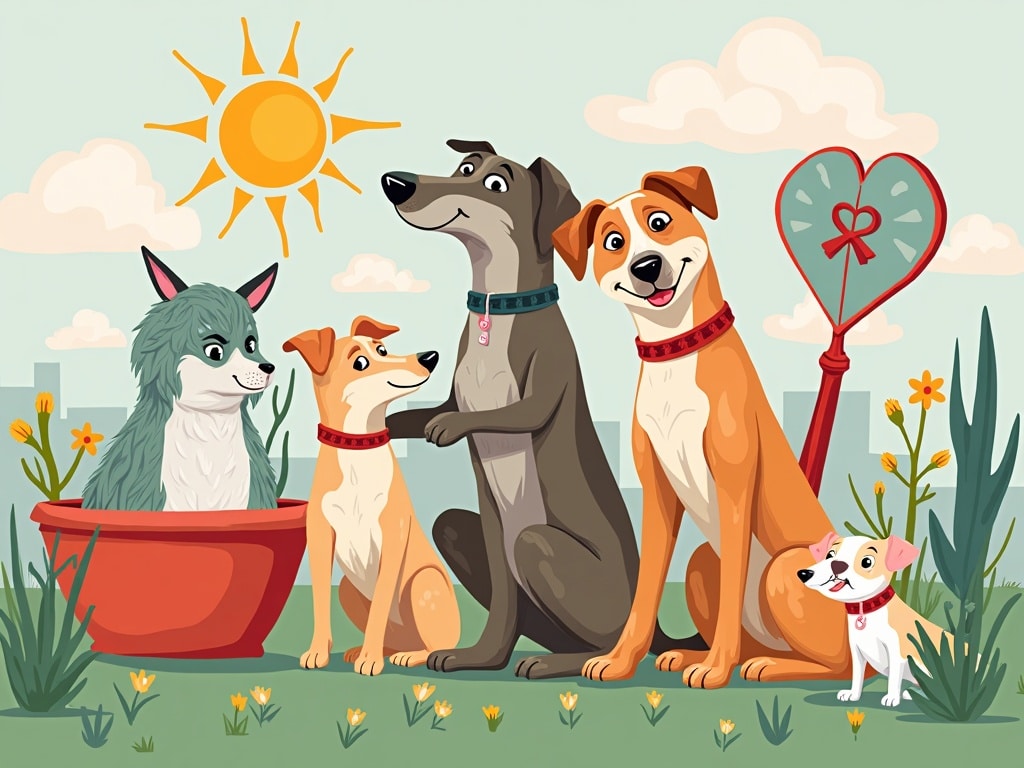First 72 Hours: Creating a Safe and Secure World for Your Rescue Dog
Bringing a rescue dog into your home is a deeply rewarding experience, but it’s also one that requires careful preparation and understanding. Those crucial first 72 hours set the stage for your dog’s long-term adjustment and well-being. Imagine your new companion, perhaps a little scared, unsure, and overwhelmed by their new surroundings. Your mission, should you choose to accept it (and you have!), is to create a haven of safety and security. This comprehensive guide will walk you through every step, ensuring a smooth transition for both you and your furry friend.
Understanding Your Rescue Dog’s Background: Trauma, Anxiety, and Adjustment
Before your rescue dog even sets a paw inside your home, it’s vital to acknowledge that they likely come with a past – one that may be filled with unknowns, and potentially, trauma. They might have experienced neglect, abandonment, or even abuse. This can manifest in a variety of ways, including anxiety, fearfulness, and difficulty trusting new people and environments. It’s crucial to approach your new dog with patience, empathy, and a willingness to understand their unique history.
- Trauma: Look for signs of past trauma, such as flinching, cowering, or excessive barking at sudden movements or loud noises.
- Anxiety: An anxious dog may exhibit panting, pacing, lip licking, or a tucked tail.
- Adjustment: Remember that it takes time for a dog to adjust to a new home. Don’t expect them to be fully comfortable and confident right away.
Knowing as much as possible about your dog’s history from the rescue organization can be invaluable. Ask about their previous living situation, any known triggers, and their general temperament. However, be prepared for the fact that some information may be unavailable, and you’ll need to rely on observation and patience to truly understand your dog’s needs.
Preparing Your Home: Inside and Out (Before Your Dog Arrives)
Think of preparing your home as building a safe and welcoming sanctuary. Before your rescue dog arrives, take the time to dog-proof your space and create a comfortable environment. This includes both the interior and exterior of your home.
Inside Your Home:
- Remove hazards: Secure or remove any items that could be harmful if ingested, such as cleaning supplies, medications, and small objects that could be choking hazards.
- Protect furniture: Cover furniture with blankets or throws to protect it from potential accidents or scratching.
- Provide comfortable bedding: Set up a designated sleeping area with a comfortable bed, blankets, and toys.
- Gather essential supplies: Food and water bowls, leash, collar, and identification tag are must-haves.
Outside Your Home:
- Secure your yard: Ensure that your fence is secure and free of escape routes.
- Remove toxic plants: Identify and remove any plants that are poisonous to dogs.
- Create a potty area: Designate a specific area for your dog to relieve themselves.
By taking these precautions, you’re minimizing potential risks and creating a safe and secure environment for your new dog to explore.
The First 72 Hours: A Detailed Timeline
The first 72 hours are crucial for setting the tone for your relationship with your rescue dog. Here’s a detailed timeline to guide you through each step:
Day 1: Arrival and Introduction
- Arrival: Keep things calm and quiet. Let your dog explore their new surroundings at their own pace. Avoid overwhelming them with too much attention.
- Potty break: Immediately take your dog to the designated potty area and encourage them to relieve themselves. Praise them enthusiastically if they do.
- Introduction to the house: Allow your dog to explore one or two rooms initially, rather than giving them free rein of the entire house.
- Feeding: Offer a small meal in a quiet area. Don’t be surprised if they don’t eat much on the first day.
Day 2: Building Trust
- Routine: Begin establishing a consistent routine for feeding, potty breaks, and walks.
- Quiet time: Provide plenty of opportunities for rest and relaxation in their safe space.
- Gentle interaction: Offer gentle petting and talk to your dog in a calm, soothing voice. Avoid forcing interaction if they seem uncomfortable.
Day 3: Continued Observation and Bonding
- Monitor body language: Pay close attention to your dog’s body language to understand their comfort level and identify any potential stressors.
- Short walks: Begin taking short, leashed walks in your neighborhood to help your dog acclimate to their new environment.
- Continue routine: Reinforce the established routine and provide consistent positive reinforcement.
Remember, every dog is different, and some may adjust more quickly than others. Be patient and flexible, and adjust your approach as needed.
Creating a Safe Space: Den, Crate, or Designated Area
Providing your rescue dog with a safe space is paramount to their well-being. This could be a crate, a den-like area, or simply a designated corner of a room. The key is to create a space where your dog feels secure and can retreat to when they feel overwhelmed or anxious.
- Crate training: If you choose to use a crate, introduce it gradually and make it a positive experience. Never use the crate as punishment.
- Den-like area: A den-like area can be created by placing a bed in a quiet corner and covering it with a blanket to create a sense of enclosure.
- Comfort items: Include comfortable bedding, toys, and a water bowl in the safe space.
Encourage your dog to use their safe space by rewarding them with treats and praise when they go inside. Never force them to go into the space if they are reluctant.
Establishing Routine and Boundaries
Dogs thrive on routine and consistency. Establishing clear boundaries and a predictable routine will help your rescue dog feel more secure and confident in their new environment.
- Feeding schedule: Feed your dog at the same time each day.
- Potty breaks: Take your dog outside to relieve themselves at regular intervals.
- Walks: Establish a regular walking schedule.
- Training basics: Begin teaching basic commands such as sit, stay, and come using positive reinforcement methods.
Consistency is key. Make sure that everyone in the family is on board with the established routine and boundaries.

Monitoring Body Language and Stress Signals
Learning to read your dog’s body language is essential for understanding their emotional state and identifying potential stressors. Recognizing stress signals early on can help you prevent situations that may overwhelm your dog.
- Common stress signals:
- Panting (when not hot or after exercise)
- Pacing
- Lip licking
- Yawning (when not tired)
- Whale eye (showing the whites of their eyes)
- Tucked tail
- Ears pinned back
- Trembling
If you notice any of these stress signals, remove your dog from the situation and allow them to retreat to their safe space. Consult with a veterinarian or behaviorist if you are concerned about your dog’s stress levels.
Introducing Family Members and Other Pets
Introducing your rescue dog to family members and other pets requires a gradual and supervised approach. Avoid overwhelming your dog with too many new faces or interactions at once.
- Family members: Introduce family members one at a time in a calm and quiet setting. Allow your dog to approach them at their own pace.
- Other pets: Keep initial interactions brief and supervised. Introduce pets on neutral territory, such as a walk in the park. Monitor their body language closely and separate them if you notice any signs of aggression or discomfort.
Never leave your rescue dog unsupervised with other pets until you are confident that they are comfortable and safe together.
Common Challenges and Solutions
Bringing a rescue dog into your home can come with its own set of challenges. Here are some common issues and potential solutions:
- Separation anxiety:
- Challenge: Excessive barking, destructive behavior, or urinating/defecating when left alone.
- Solution: Gradual desensitization, providing enrichment activities, and consulting with a veterinarian or behaviorist.
- Destructive behavior:
- Challenge: Chewing furniture, digging, or scratching.
- Solution: Providing plenty of appropriate chew toys, increasing exercise, and addressing underlying anxiety.
- Fearfulness:
- Challenge: Cowering, hiding, or trembling in response to certain stimuli.
- Solution: Identifying and avoiding triggers, using positive reinforcement to build confidence, and consulting with a veterinarian or behaviorist.
Remember, patience and consistency are key to overcoming these challenges. Don’t hesitate to seek professional help if you are struggling to manage your dog’s behavior.
Essential Supplies for the First 72 Hours (and Beyond)
Having the right supplies on hand will make the transition process much smoother for both you and your rescue dog. Here’s a checklist of essential items:
- Food and water bowls
- High-quality dog food
- Leash and collar with identification tag
- Comfortable bed and blankets
- Crate (optional)
- Chew toys and enrichment activities
- Poop bags
- Cleaning supplies for accidents
- Pet carrier (for vet visits)
Consider creating a rescue dog starter kit to have everything you need readily available when your dog arrives.
Finding Professional Help
Navigating the challenges of bringing a rescue dog into your home can sometimes require professional guidance. Don’t hesitate to seek help from a veterinarian, trainer, or behaviorist if you are struggling.
- Veterinarian: For routine checkups, vaccinations, and addressing any medical concerns.
- Trainer: For basic obedience training and addressing behavior issues.
- Behaviorist: For complex behavioral issues, such as anxiety, aggression, or fearfulness.
A qualified professional can provide personalized support and guidance to help you and your rescue dog thrive.
Bringing a rescue dog into your life is an incredible journey, filled with love, challenges, and immense rewards. By preparing your home, understanding your dog’s background, and providing a safe and secure environment, you can set the stage for a happy and fulfilling life together. Remember, patience, empathy, and consistency are your greatest tools. Embrace the unique personality of your rescue dog, celebrate their small victories, and cherish the unbreakable bond you’ll create. Welcome home!

